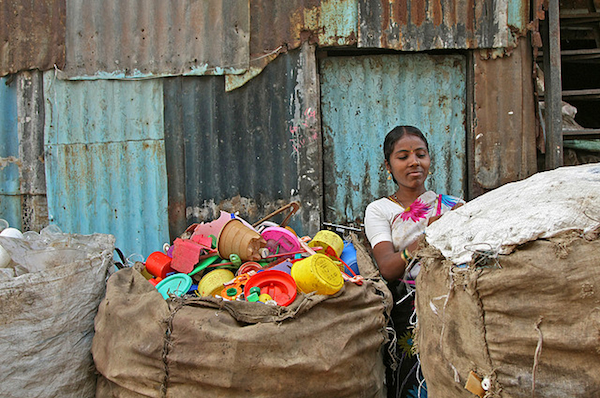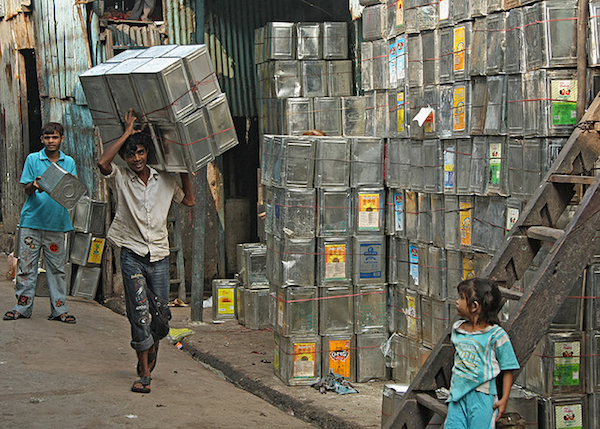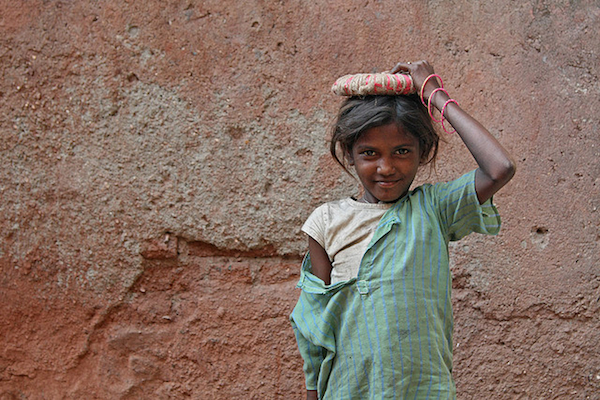Mumbai
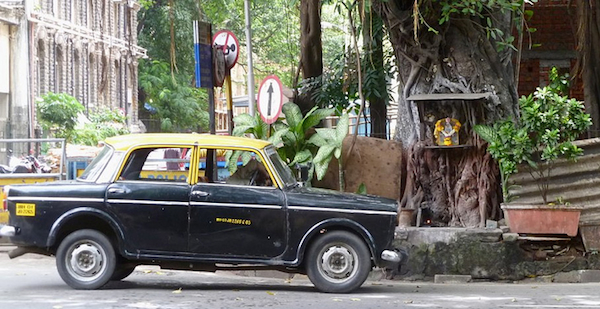
I went to Mumbai last week–mainly because we had finally got through the madness of our graduation, exhibition and fashion show at college and I wanted to get away for a few days, but also because I was really curious to see what the city is like.
Everyone told me that it would be crazy and crowded and noisy, but I really liked the place. Admittedly though, I did spend the first day or two in the slightly more well-heeled South of the city, around Colaba, which feels very cosmopolitan and has some great little cafés and restaurants serving Western food. It was great to find some good coffee, nice bread and a decent salad.
When I’m on holiday I really like to wander around a place and look at the architecture, and Mumbai turned out to be ideal for this… not only was the late monsoon weather relatively cool (well, around 28 with a decent breeze), but there are also lots of interesting old buildings in a variety of styles, including a surprising amount of crumbling old Art Deco. It’s also full of cute little Premier Padmini taxis, which are basically a 1960’s Fiat 1100. All of this lends the place an air of faded retro glamour.
While I was there I realised that one thing that Bangalore really lacks is a sense of history–as you might expect in a city that has doubled in size in 20 years, almost everything looks new. So to me, Mumbai felt like it has much more of a character, and stories it could tell.

It’s also by the sea of course, and there was something about arriving at the West coast and seeing the ocean and the palm trees that reminded me of, erm… Los Angeles. Maybe.

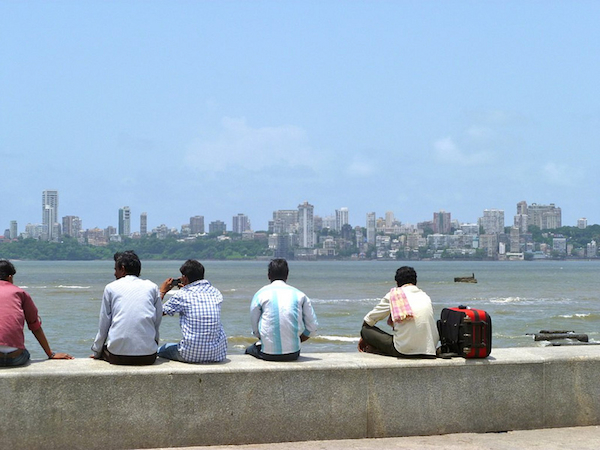

Slums
Mumbai is a huge city, the biggest in India and the 4th largest city proper in the world, with a population around 12 million people–or up to 23 million depending on how you count. And one of the things it’s known for is its slums.
I knew there would be slums there, but I was astounded to see them absolutely everywhere as the plane came in to land and we flew low over the city. All around, tiny shacks were clinging to hillsides and crammed into any available space, even right up to the edge of the airport runway. Blue tarpaulins and rusty corrugated tin roofs extended as far as the eye could see.
According to the 2011 census, 78% of Mumbai’s city population lives in slums. That’s more than 9 million people, about the same as the population of Sweden. In Slums. In just one city.
I really can’t get my head around that at all.
Mumbai’s most famous slum is Dharavi, as featured in the movie Slumdog Millionaire among several others. Until recently it was known as “Asia’s biggest slum” but as of 2011 there are now at least 4 others which are even bigger, just in Mumbai alone. And Dharavi’s population is reckoned to have now reached 1 million people. All living in an area of one square mile.
Apart from anything else, this gives you an idea of the speed at which the population is growing.
I decided to go and visit.
Lonely Planet recommends a tour by Reality Tours & Travel, who also run the non-profit organisation Reality Gives which supports a broad range of really interesting educational and development projects in Dharavi itself, including a girls’ football team and teaching bee-keeping to local people. So although the idea of “Slum Tourism” might be rather distasteful to some, I wanted to see the place and the people for myself so that I could understand the situation better. And knowing that the money I spent on it would support the community made it seem worthwhile, and a better idea than just wandering around the place alone.
So on a very wet Monday morning I set off to Churchgate station to meet with the tour guide and catch a train to Dharavi. I had already watched the documentaries on Dharavi that Channel 4 put out a couple of years ago, so I was expecting the visit to be pretty grim.
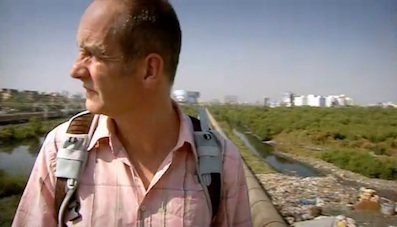
Kevin McCloud: Slumming It. Channel 4, 2010.
Episode 1 and Episode 2 watchable online, UK only.
But in the end I found it a really positive and inspiring experience. Yes, people are living and working in some pretty awful conditions, but Dharavi is a surprisingly well-developed society–a fully functioning city within a city–and it’s home to thousands of small businesses, with a combined annual turnover of around US$650 million. There is high employment and very little crime.
The tour guide, one of a team of local students who do the work in their spare time, repeatedly told us with a smile that Dharavi is a “5-star slum”, and that it has a bank, a cinema, even a video game parlour and an ATM. Some of the residents have even become relatively wealthy, and we were proudly shown a couple of CCTV cameras that were pointing at parked cars in one of the “up-market” neighbourhoods.
Not that any of this makes it remotely glamorous, or even normal. Small children squat in the street to go to the toilet. Living conditions are extremely cramped, and most buildings have 2 stories with the upper level reached only by a very steep iron ladder that you have to descend backwards. A maze of tiny passageways snakes between the houses–so narrow that you can’t pass through with your umbrella up.
Generally speaking, it feels like how you would imagine a medieval European city would have been.
But still, the industrial revolution is very much in evidence here, and at every turn we came across another small business: recycling plastics, cardboard, oil drums and cooking-oil cans; making pottery, clothes, cakes; or tanning leather. Absolutely everyone seemed busy working. And once again the overwhelming cheerfulness of the local people… all the school-children we passed said “hi!” and greeted us with big smiles, and many of the adults too. Even though it was absolutely bucketing down with monsoon rain. And, unusually for an Indian city, nobody at all was begging.
Cameras weren’t allowed on the tour so I don’t have any pictures of my own, but these wonderful photos by Meena Kadri (aka Meanest Indian) do a great job of showing Dharavi’s people and industries.
(See the whole set.)
Watching the Channel 4 film again, and seeing Kevin McCloud squirming (his first time ever in India and he stays in Dharavi for over a week!), it makes me realise how much I’ve become used to seeing poverty and rubbish everywhere, and how the rag-pickers in our midst use one to fight the other. Not that I’m immune to it–far from it. The poverty is still distressing, but it no longer shocks me with the same intensity that it did when I first arrived here.
Maybe it was a deliberate decision by the tour guide, but we didn’t really see much of the filthy squalor shown on the documentaries–particularly around the “pipeline” area. Since it was raining really hard, and because the one other person on the tour with me had foolishly made a lunchtime appointment that she had to be back in town for, we ended up going round the place fairly quickly. So maybe we cut some bits out, or maybe some of the nasty stuff was hidden underwater–it was ankle deep in rainwater in many places. (And I was wondering what else might be in there–they have Cholera outbreaks from time to time due to the lack of sanitation.)
The real squalor is definitely there though, and not just in Dharavi. Catching a suburban train back to the relatively affluent South of Mumbai, the route took us past some really dire places. A delapidated, derelict old building dripping with rain and covered in ferns, with an elderly couple lying on cots in an open corridor. Small children looking out of glassless windows as the train goes past. Tiny patchwork shacks a couple of metres wide, built from hundreds of random boards and metal sheets, and all jammed together right up next to the railway. Whole families living under blue tarpaulins on the pavement, next to a busy 6-lane highway.
But what really struck me about the people in Dharavi is that they have a functioning and vibrant community where they can work and go to school, and that this brings them dignity and opportunity.
Put simply, they belong there. They own it. The people built Dharavi for themselves, out of nothing, and they continue to develop it. It has been called “the ultimate user-generated city”.
Perhaps this is why so many of Dharavi’s entrepreneurs and business-owners prefer to stay, even though they have become relatively wealthy.
On the other hand, the options for moving out would also be extremely limited, since Mumbai is arguably the most expensive place to live in India. Property prices are through the roof, probably due to the city’s status as financial capital of the country, as well as being the home of the Bollywood film industry and many of its stars.
When I had just arrived, one of the first landmarks I spotted as my airport taxi drove into Mumbai was Antilia, the 27-storey “home” built by billionaire industrialist Mukesh Ambani, India’s richest man. I recognised it straight away, because I had read about it only recently.
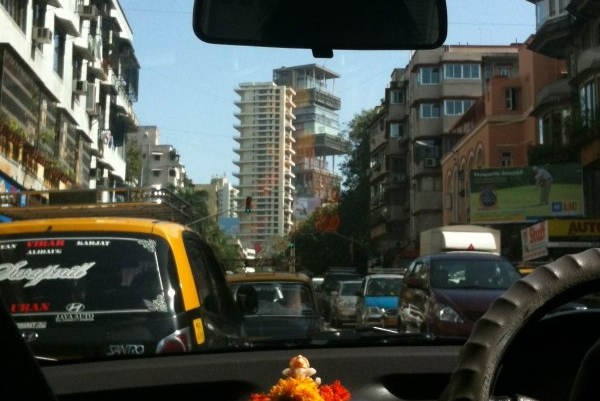
The audacity of this project is almost as as hard to grasp as the statistics about the slums. It’s supposedly the world’s most expensive house, at around US$1-2 billion. It has 3 helipads and parking space for 168 cars, taking up 6 floors.
And of course, it would be looking down onto a number of slums.

So once again we come back to the theme of India being a place of contradictions and contrasts. And it’s hard to imagine more contrast than a mega-city that’s home to movie stars, bankers and billionaires, but where more than three quarters of the population live in slums. Or where the world’s most expensive house looks out over families who live out on the pavement.
It was only a flying visit this time, and I didn’t get to see some of the landmarks that had been on my list such as Dhobi Ghat, Elephanta Island and Chor Bazaar. But I would love to go back and see more of Mumbai.
I have a small set of Mumbai photos on flickr. For those in the UK, the Channel 4 documentaries are highly recommended as well: Episode 1, Episode 2.

